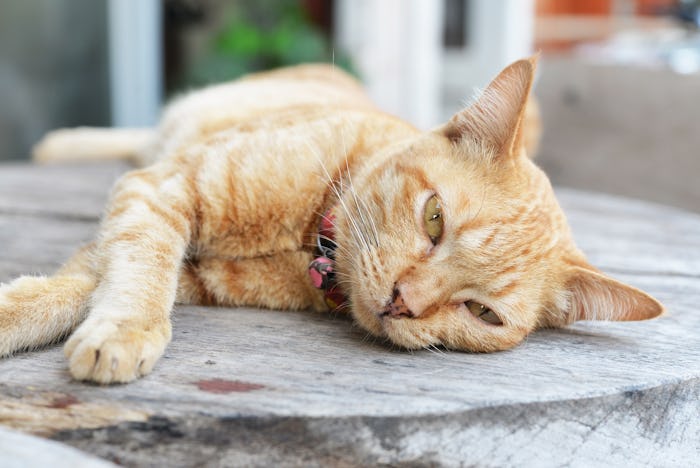Life

Cats Are Known For Being Aloof, But Here's When Their Behavior Means They're Sick
Some cats are cuddly, vocal, and social. Some are independent, stealthy, and tend to lay low. But if your kitty’s usual behavior or personality starts changing, it can be a sign they don’t feel well. It’s important to know how to tell if your cat is in pain, and what to do next if you think they may be hurting.
PetMD.com cited a report which found 25 possible signs that a cat is in pain. Daniel Eckman, DVM, veterinarian at Veterinary Medical Teaching Hospital of Texas A&M University, tells Romper via phone interview that this is true — cats can exhibit a number of behavioral changes when they’re not feeling well.
“One of the biggest ones we see is a reluctance to jump, or not being able to hump as high as they once could,” Eckman says. “They may not be able to get in and out of the litter box, so they may urinate or defecate on the floor. Some of them may vocalize or move away from you when you’re touching them. It may seem they can’t get comfortable. Others, you can see some changes in facial features where their eyes may be staring off into space or their pupils may be dilated.”
Cats who aren’t feeling well can also isolate themselves from their owners and animal family members. So if your kid is wondering why their snuggle buddy of a cat is lackluster about bedtime, it might be a bad sign. “We can see them move away from locations where they may get more interaction with people or other pets. It’s two-fold because it’s evolutionary — they try to hide the pain as long as they can so their own group doesn’t single them out. Second, if they are in pain, interactions may also be more painful for them,” says Eckman.
Some other examples Eckman provided include sleeping in unusual positions or locations, being more withdrawn from people or other animals, changes in appetite, and either stopping grooming altogether or overgrooming certain areas of the body. “Especially with arthritis, if an area is painful, they may lick at that joint constantly,” he explains, adding that arthritis is one of the more common causes of pain in cats.
“As far as common causes of pain in cats, arthritis can be a big cause. Trauma of some sort, or cancers can be a big cause. Both kidney disease and lower urinary tract disease are common and can cause pain. Pancreatitis is another source of pain,” Eckman says.
Cat parents should be aware of these signs of pain and sickness so they can spot behavioral changes in their pet. If your cat seems off, it’s best to call a vet and let them figure out exactly what’s bothering your kitty. I know, you already take enough little beings to doctors, but this is serious. “Unfortunately, with cats, even showing one of those signs can be enough to take them to the vet,” Eckman says. “I don’t recommend people try to find the source of pain at home, because you may inflict more discomfort on the cat, and cats may bite at you when they’re uncomfortable.”
Eckman says owners just need to make their vet appointment and report the behavioral change that’s causing concern. Once your cat is in the exam room, they can begin figuring out exactly where the pain is coming from and what can be done to fix it.
“We usually start with a thorough physical examination in which we put all the joints within a range of motion, feeling the back and muscles, looking for changes in things like breathing or dilating pupils, or if the pet wants to move away from you to help us isolate sources of pain. From there we would do diagnostic testing to find underlying causes of that pain,” explains Eckman. “Sometimes we do all that and can’t identify the source of the pain, so we end up treating for the pain to see if we can resolve it, but that’s not as common.”
Eckman recommends the International Veterinary Academy of Pain Management’s pet owner blog for more information and education on pets and pain. Just keep an eye on your sweet kitty's behavior and be vigilant.
This article was originally published on